An AI-Based Fast Design Method for New Centrifugal Compressor Families
Abstract
:1. Introduction
2. Materials and Methods
2.1. Step 1: 1D Single-Zone Model Implementation and Validation
2.2. Step 2: ANOVA
2.3. Step 3: Sobol Sequence
2.4. Step 4: Artificial Neural Network
2.5. Step 5: Validation of Promising Solutions through CFD Analyses
3. Results and Discussion
3.1. Step 1: Validation of 1D Single-Zone Model
3.2. Step 2: ANOVA Results
3.3. Step 3: Sobol Sequence
3.4. Step 4: Artificial Neural Network
3.5. Step 5: Validation of Promising Solutions through CFD Analyses
4. Conclusions
Author Contributions
Funding
Institutional Review Board Statement
Data Availability Statement
Acknowledgments
Conflicts of Interest
Nomenclature
| Area | |
| Velocity of sound | |
| Blade height | |
| Absolute velocity | |
| Friction coefficient | |
| Specific heat ratio | |
| Diameter | |
| Diffusion factor | |
| Incidence factor | |
| Entalpy | |
| Specific entalpy | |
| Specific heat ratio | |
| Blade length | |
| Mass flow rate | |
| Peripheral Mach number | |
| Pressure | |
| Volume flow rate | |
| Radius | |
| Specific entropy | |
| Temperature | |
| Thickness | |
| Peripheral velocity | |
| Relative velocity | |
| Effective number of blades | |
| Variation | |
| Absolute angle | |
| Relative angle/pressure ratio | |
| Blade slope angle | |
| Wake fraction of blade-to-blade space | |
| Polytropic efficiency | |
| Work coefficient | |
| Flow coefficient | |
| Polytropic head | |
| Subscripts | |
| 0 | Total quantity |
| 1 | Impeller inlet |
| 2 | Impeller outlet |
| 3 | Diffuser outlet |
| 4 | Volute outlet |
| bl | Blade |
| bld | Blade loading |
| ch | Choke |
| cl | Clearance |
| df | Disc friction |
| e | Exit cone |
| h | hub |
| hs | Hub-to-shroud distortion |
| hyd | Hydraulic |
| in | incidence |
| LE | Leading edge |
| lk | leakage |
| m | Meridional component |
| mix | mixing |
| p | Polytropic |
| rc | Recirculation |
| s | Shroud |
| sf | Skin friction |
| spl | Splitter |
| TE | Trailing edg |
| th | Throat |
| tt | Total to total |
| u | Circumferential component |
| vcv | Volute circumferential velocity |
| vld | Vaneless diffuser |
| vmv | Volute meridional velocity |
| vsf | Volute skin friction |
| Superscripts | |
| * | Sonic condition/scaling factor |
| - | Average |
References
- National Oceanic and Atmospheric Administration. Available online: http://www.noaa.gov/ (accessed on 28 October 2021).
- Climate Change: Vital Signs of the Planet. Available online: https://climate.nasa.gov/ (accessed on 28 October 2021).
- Climatic Research Unit-Groups and Centres-UEA. Available online: https://www.uea.ac.uk/groups-and-centres/climatic-research-unit (accessed on 28 October 2021).
- IPCC. Climate Change Widespread, Rapid, and Intensifying, IPCC. Available online: https://www.ipcc.ch/2021/08/09/ar6-wg1-20210809-pr/ (accessed on 28 October 2021).
- UNFCCC. The Paris Agreement. Available online: https://unfccc.int/process-and-meetings/the-paris-agreement/the-paris-agreement (accessed on 21 September 2021).
- Rockström, J.; Gaffney, O.; Rogelj, J.; Meinshausen, M.; Nakicenovic, N.; Schellnhuber, H.J. A Roadmap for Rapid Decarbonization. Science 2017, 355, 1269–1271. [Google Scholar] [CrossRef]
- De La Peña, L.; Guo, R.; Cao, X.; Ni, X.; Zhang, W. Accelerating the Energy Transition to Achieve Carbon Neutrality. Resour. Conserv. Recycl. 2022, 177, 105957. [Google Scholar] [CrossRef]
- Ram, M.; Osorio-Aravena, J.C.; Aghahosseini, A.; Bogdanov, D.; Breyer, C. Job Creation during a Climate Compliant Global Energy Transition across the Power, Heat, Transport, and Desalination Sectors by 2050. Energy 2022, 238, 121690. [Google Scholar] [CrossRef]
- Giovannelli, A. Development of Turbomachines for Renewable Energy Systems and Energy-Saving Applications. Energy Procedia 2018, 153, 10–15. [Google Scholar] [CrossRef]
- Fattouh, B.; Poudineh, R.; West, R. The Rise of Renewables and Energy Transition: What Adaptation Strategy Exists for Oil Companies and Oil-Exporting Countries? Energy Transit. 2019, 3, 45–58. [Google Scholar] [CrossRef]
- Mahmoud-Jouini, S.B.; Midler, C.; Garel, G. Time-to-Market vs. Time-to-Delivery: Managing Speed in Engineering, Procurement and Construction Projects. Int. J. Proj. Manag. 2004, 22, 359–367. [Google Scholar] [CrossRef]
- Came, P.M.; Robinson, C.J. Centrifugal Compressor Design. Proc. Inst. Mech. Eng. Part C J. Mech. Eng. Sci. 1998, 213, 139–155. [Google Scholar] [CrossRef]
- Krain, H. Review of Centrifugal Compressor’s Application and Development. J. Turbomach. 2005, 127, 25–34. [Google Scholar] [CrossRef]
- Violette, M.; Cyril, P.; Jürg, S. Data-Driven Predesign Tool for Small-Scale Centrifugal Compressor in Refrigeration. J. Eng. Gas Turbines Power 2018, 140, 121011. [Google Scholar] [CrossRef]
- Casey, M.; Robinson, C. A Method to Estimate the Performance Map of a Centrifugal Compressor Stage. J. Turbomach. 2013, 135, 021034. [Google Scholar] [CrossRef]
- Al-Busaidi, W.; Pilidis, P. A New Method for Reliable Performance Prediction of Multi-Stage Industrial Centrifugal Compressors Based on Stage Stacking Technique: Part I–Existing Models Evaluation. Appl. Therm. Eng. 2016, 98, 10–28. [Google Scholar] [CrossRef]
- Japikse, D.; Baines, N.C. Introduction to Turbomachinery; Concepts Eti Norwich: Norwich, VT, USA, 1994. [Google Scholar]
- Dean, R.C., Jr.; Senoo, Y. Rotating Wakes in Vaneless Diffusers. J. Basic Eng. 1960, 82, 563–570. [Google Scholar] [CrossRef]
- Japikse, D. Assessment of Single-and Two-Zone Modeling of Centrifugal Compressors, Studies in Component Performance: Part 3. In Proceedings of the Turbo Expo: Power for Land, Sea and Air, Houston, TX, USA, 18–21 March 1985; Volume 79382, p. 001. [Google Scholar]
- Harley, P.; Spence, S.; Filsinger, D.; Dietrich, M.; Early, J. An Evaluation of 1D Design Methods for the Off-Design Performance Prediction of Automotive Turbocharger Compressors. In Proceedings of the Turbo Expo 2012, Copenhagen, Denmark, 11–15 June 2012; American Society of Mechanical Engineers. Volume 44748, pp. 915–925. [Google Scholar]
- Casey, M.; Robinson, C. A New Streamline Curvature Throughflow Method for Radial Turbomachinery. J. Turbomach. 2010, 132, 031021. [Google Scholar] [CrossRef]
- Eckardt, D. Detailed Flow Investigations within a High-Speed Centrifugal Compressor Impeller. J. Fluids Eng. 1976, 98, 390–399. [Google Scholar] [CrossRef]
- Cravero, C.; Leutcha, P.J.; Marsano, D. Simulation and Modeling of Ported Shroud Effects on Radial Compressor Stage Stability Limits. Energies 2022, 15, 2571. [Google Scholar] [CrossRef]
- Lüdtke, K.H. Process Centrifugal Compressors: Basics, Function, Operation, Design, Application; Springer Science & Business Media: Berlin/Heidelberg, Germany, 2004. [Google Scholar]
- Vidil, R.; Marvillet, C. The Innovation Process in the Energy Field. Energy 2005, 30, 1233–1246. [Google Scholar] [CrossRef]
- Hazby, H.; Casey, M.; Březina, L. Effect of Leakage Flows on the Performance of a Family of Inline Centrifugal Compressors. J. Turbomach. 2019, 141, 091006. [Google Scholar] [CrossRef]
- Edwards-Schachter, M. The Nature and Variety of Innovation. Int. J. Innov. Stud. 2018, 2, 65–79. [Google Scholar] [CrossRef]
- Hazby, H.; Casey, M.; Robinson, C.; Spataro, R.; Lunacek, O. The Design of a Family of Process Compressor Stages. In Proceedings of the 12th European Conference on Turbomachinery Fluid dynamics & Thermodynamics, Stockholm, Sweden, 3–7 April 2017. [Google Scholar]
- Bygrave, J.; Villanueva, A.; Enos, R.; Saladino, A.; Serrino, D.; Prosser, W. Upgrading the Performance of a Centrifugal Barrel Compressor Family. In Proceedings of the Turbo Expo: Power for Land, Sea and Air, Glasgow, UK, 14–18 June 2010; Volume 44007, pp. 789–802. [Google Scholar]
- Casey, M.; Gersbach, F.; Robinson, C. An Optimization Technique for Radial Compressor Impellers. In Proceedings of the Turbo Expo: Power for Land, Sea and Air, Berlin, Germany, 9–13 June 2008; Volume 43161, pp. 2401–2411. [Google Scholar]
- Li, P.-Y.; Gu, C.-W.; Song, Y. A New Optimization Method for Centrifugal Compressors Based on 1D Calculations and Analyses. Energies 2015, 8, 4317–4334. [Google Scholar] [CrossRef]
- Khan, Z.H.; Alin, T.S.; Hussain, M.A. Price Prediction of Share Market Using Artificial Neural Network (ANN). Int. J. Comput. Appl. 2011, 22, 42–47. [Google Scholar]
- Checcucci, M.; Sazzini, F.; Marconcini, M.; Arnone, A.; Coneri, M.; De Franco, L.; Toselli, M. Assessment of a Neural-Network-Based Optimization Tool: A Low Specific-Speed Impeller Application. Int. J. Rotating Mach. 2011, 2011, 817547. [Google Scholar] [CrossRef]
- Ronald, H. Centrifugal Compressors: A Strategy for Aerodynamic Design and Analysis; American Society of Mechanical Engineers Press: New York, NY, USA, 2000. [Google Scholar]
- Oh, H.W.; Yoon, E.S.; Chung, M.K. An Optimum Set of Loss Models for Performance Prediction of Centrifugal Compressors. Proc. Inst. Mech. Eng. Part A J. Power Energy 1997, 211, 331–338. [Google Scholar] [CrossRef]
- Galvas, M.R. Fortran Program for Predicting Off-Design Performance of Centrifugal Compressors; National Aeronautics and Space Administration: Washington, DC, USA, 1973; Volume 7487. [Google Scholar]
- Khoshkalam, N.; Mojaddam, M.; Pullen, K.R. Characterization of the Performance of a Turbocharger Centrifugal Compressor by Component Loss Contributions. Energies 2019, 12, 2711. [Google Scholar] [CrossRef]
- Velásquez, E.I.G. Determination of a Suitable Set of Loss Models for Centrifugal Compressor Performance Prediction. Chin. J. Aeronaut. 2017, 30, 1644–1650. [Google Scholar] [CrossRef]
- Zhang, C.; Dong, X.; Liu, X.; Sun, Z.; Wu, S.; Gao, Q.; Tan, C. A Method to Select Loss Correlations for Centrifugal Compressor Performance Prediction. Aerosp. Sci. Technol. 2019, 93, 105335. [Google Scholar] [CrossRef]
- Sundström, E.; Kerres, B.; Sanz, S.; Mihăescu, M. On the Assessment of Centrifugal Compressor Performance Parameters by Theoretical and Computational Models. In Proceedings of the Turbo Expo: Power for Land, Sea and Air, Charlotte, NC, USA; American Society of Mechanical Engineers: Charlotte, NC, USA, 2017; Volume 50800, p. 02. [Google Scholar]
- Kus, B.; Nekså, P. Development of One-Dimensional Model for Initial Design and Evaluation of Oil-Free Co2 Turbo-Compressor. Int. J. Refrig. 2013, 36, 2079–2090. [Google Scholar] [CrossRef]
- Ameli, A.; Afzalifar, A.; Turunen-Saaresti, T.; Backman, J. Centrifugal Compressor Design for Near-Critical Point Applications. J. Eng. Gas Turbines Power 2019, 141, 031016. [Google Scholar] [CrossRef]
- Romei, A.; Gaetani, P.; Giostri, A.; Persico, G. The Role of Turbomachinery Performance in the Optimization of Supercritical Carbon Dioxide Power Systems. J. Turbomach.-Trans. ASME 2020, 142, 071001. [Google Scholar] [CrossRef]
- Mei, Z.; Cao, T.; Hwang, Y. 1D Design and Optimization of a Micro-Centrifugal Compressor for an Air Conditioner Using R600a. In Proceedings of the 25th International Compressor Engineering Conference, Purdue, IN, USA, 24–28 May 2021. [Google Scholar]
- Xia, W.; Zhang, Y.; Yu, H.; Han, Z.; Dai, Y. Aerodynamic Design and Multi-Dimensional Performance Optimization of Supercritical CO2 Centrifugal Compressor. Energy Convers. Manag. 2021, 248, 114810. [Google Scholar] [CrossRef]
- Wang, J.; Guo, Y.; Zhou, K.; Xia, J.; Li, Y.; Zhao, P.; Dai, Y. Design and Performance Analysis of Compressor and Turbine in Supercritical CO2 Power Cycle Based on System-Component Coupled Optimization. Energy Convers. Manag. 2020, 221, 113179. [Google Scholar] [CrossRef]
- Bourabia, L.; Abed, C.B.; Cerdoun, M.; Khalfallah, S.; Deligant, M.; Khelladi, S.; Chettibi, T. Aerodynamic Preliminary Design Optimization of a Centrifugal Compressor Turbocharger Based on One-Dimensional Mean-Line Model. Eng. Comput. 2021, 38, 3438–3469. [Google Scholar] [CrossRef]
- Du, Y.; Yang, C.; Wang, H.; Hu, C. One-Dimensional Optimisation Design and off-Design Operation Strategy of Centrifugal Compressor for Supercritical Carbon Dioxide Brayton Cycle. Appl. Therm. Eng. 2021, 196, 117318. [Google Scholar] [CrossRef]
- Massoudi, S.; Picard, C.; Schiffmann, J. Robust Design Using Multiobjective Optimisation and Artificial Neural Networks with Application to a Heat Pump Radial Compressor. Des. Sci. 2022, 8, E1. [Google Scholar] [CrossRef]
- Konstantinov, S.V.; Diveev, A.I.; Balandina, G.I.; Baryshnikov, A.A. Comparative Research of Random Search Algorithms and Evolutionary Algorithms for the Optimal Control Problem of the Mobile Robot. Procedia Comput. Sci. 2019, 150, 462–470. [Google Scholar] [CrossRef]
- Harley, P.X.L. Improved Meanline Modelling of Centrifugal Compressors for Automotive Turbochargers. Ph.D. Thesis, Queen’s University Belfast, Belfast, UK, 2014. [Google Scholar]
- Amirante, R.; De Bellis, F.; Distaso, E.; Tamburrano, P. An Explicit, Non-Iterative, Single Equation Formulation for an Accurate One Dimensional Estimation of Vaneless Radial Diffusers in Turbomachines. J. Mech. 2015, 31, 113–122. [Google Scholar] [CrossRef]
- Qiu, X.; Japikse, D.; Zhao, J.; Anderson, M.R. Analysis and Validation of a Unified Slip Factor Model for Impellers at Design and Off-Design Conditions. J. Turbomach. 2011, 133, 041018. [Google Scholar] [CrossRef]
- Jansen, W. A Method for Calculating the Flow in a Centrifugal Impeller When Entropy Gradient Are Present. Inst. Mech. Eng. Intern. Aerodyn. 1970, 133–146. [Google Scholar]
- Stuart, C.; Spence, S.; Kim, S.I.; Filsinger, D.; Starke, A. A 1-D Vaneless Diffuser Model Accounting for the Effects of Spanwise Flow Stratification. In Proceedings of the International Gas Turbine Congress (IGTC), Tokyo, Japan, 15–20 November 2015; pp. 15–20. [Google Scholar]
- Stanitz, J.D. One-Dimensional Compressible Flow in Vaneless Diffusers of Radial-and Mixed-Flow Centrifugal Compressors, Including Effects of Friction, Heat Transfer and Area Change; University of North Texas Libraries: Denton, TX, USA, 1952. [Google Scholar]
- Hazby, H.R.; O’Donoghue, R.; Robinson, C.J. Design and Modelling of Circular Volutes for Centrifugal Compressors. In Proceedings of the 14th International Conference on Turbochargers and Turbocharging, London, UK, 11–12 May 2021; pp. 289–301. [Google Scholar]
- Weber, C.R.; Koronowski, M.E. Meanline Performance Prediction of Volutes in Centrifugal Compressors. In Proceedings of the Turbo Expo: Power for Land Sea, and Air; American Society of Mechanical Engineers, Dusseldorf, Germany, 8–12 June 1986; Volume 79283, p. 001. [Google Scholar]
- Meroni, A.; Zühlsdorf, B.; Elmegaard, B.; Haglind, F. Design of Centrifugal Compressors for Heat Pump Systems. Appl. Energy 2018, 232, 139–156. [Google Scholar] [CrossRef]
- Conrad, O.; Raif, K.; Wessels, M. The Calculation of Performance Maps for Centrifugal Compressors with Vane-Island Diffusers. Perform. Predict. Centrif. Pumps Compress. 1979, 135–147. [Google Scholar]
- Coppage, J.E.; Dallenbach, F. Study of Supersonic Radial Compressors for Refrigeration and Pressurization Systems; Garrett Corp: Los Angeles, CA, USA, 1956. [Google Scholar]
- Johnston, J.P.; Dean, R.C., Jr. Losses in Vaneless Diffusers of Centrifugal Compressors and Pumps: Analysis, Experiment, and Design. ASME J. Eng. Power 1966, 88, 49–60. [Google Scholar] [CrossRef]
- Oh, H.W.; Yoon, E.S.; Chung, M.K. Systematic Two-Zone Modelling for Performance Prediction of Centrifugal Compressors. Proc. Inst. Mech. Eng. Part A J. Power Energy 2002, 216, 75–87. [Google Scholar] [CrossRef]
- Daily, J.W.; Nece, R.E. Chamber Dimension Effects on Induced Flow and Frictional Resistance of Enclosed Rotating Disks. J. Basic Eng. 1960, 82, 217–230. [Google Scholar] [CrossRef]
- Arnone, A. Viscous Analysis of Three-Dimensional Rotor Flow Using a Multigrid Method. J. Turbomach. 1994, 116, 435–445. [Google Scholar] [CrossRef]
- Bicchi, M.; Pinelli, L.; Marconcini, M.; Gaetani, P.; Persico, G. Numerical Study of a High-Pressure Turbine Stage with Inlet Distortions. In Proceedings of the AIP Conference Proceedings, Modena, Italy, 11–13 September 2019; Volume 2191, p. 020020. [Google Scholar]
- Wilcox, D.C. Turbulence Modeling for CFD; DCW Industries: La Canada, CA, USA, 1998; Volume 2. [Google Scholar]
- Giovannini, M.; Marconcini, M.; Arnone, A.; Dominguez, A. A Hybrid Parallelization Strategy of a Cfd Code for Turbomachinery Applications. In Proceedings of the 11th European Conference on Turbomachinery Fluid Dynamics & Thermodynamics; European Turbomachinery Society, Madrid, Spain; 2015. [Google Scholar]
- Harley, P.; Spence, S.; Filsinger, D.; Dietrich, M.; Early, J. Assessing 1D Loss Models for the Off-Design Performance Prediction of Automotive Turbocharger Compressors. In Proceedings of the Turbo Expo: Power for Land, Sea and Air; American Society of Mechanical Engineers, San Antonio, TX, USA, 3–7 June 2013; Volume 55249, p. 06. [Google Scholar]
- Shouyi, S.; Zhufeng, Y.; Lei, L.; Mengchuang, Z.; Weizhu, Y. Preliminary Design of Centrifugal Compressor Using Multidisciplinary Optimization Method. Mech. Ind. 2019, 20, 628. [Google Scholar] [CrossRef]
- Cantini, A.; Peron, M.; De Carlo, F.; Sgarbossa, F. A Decision Support System for Configuring Spare Parts Supply Chains Considering Different Manufacturing Technologies. Int. J. Prod. Res. 2022, 1–21. [Google Scholar] [CrossRef]
- Sobol’, I.M.; Asotsky, D.; Kreinin, A.; Kucherenko, S. Construction and Comparison of High-Dimensional Sobol’generators. Wilmott 2011, 2011, 64–79. [Google Scholar] [CrossRef]
- Burhenne, S.; Jacob, D.; Henze, G.P. Sampling Based on Sobol’sequences for Monte Carlo Techniques Applied to Building Simulations. Proc. Int. Conf. Build. Simulat. 2011, 1816–1823. [Google Scholar]
- Riccietti, E.; Bellucci, J.; Checcucci, M.; Marconcini, M.; Arnone, A. Support Vector Machine Classification Applied to the Parametric Design of Centrifugal Pumps. Eng. Optim. 2018, 50, 1304–1324. [Google Scholar] [CrossRef]
- Zabinsky, Z.B. Random Search Algorithms; Department of Industrial and Systems Engineering, University of Washington: Washington, MA, USA, 2009. [Google Scholar]

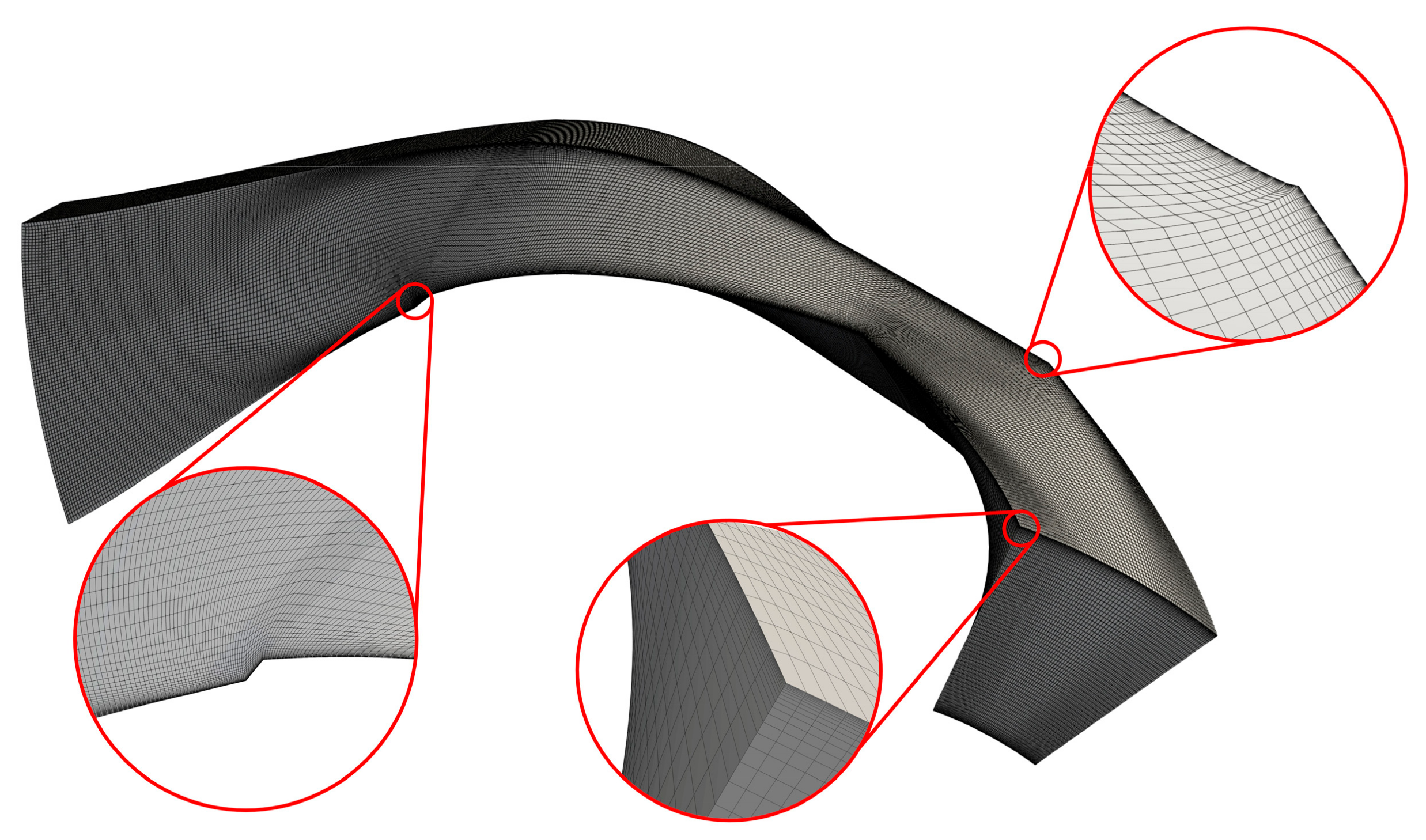
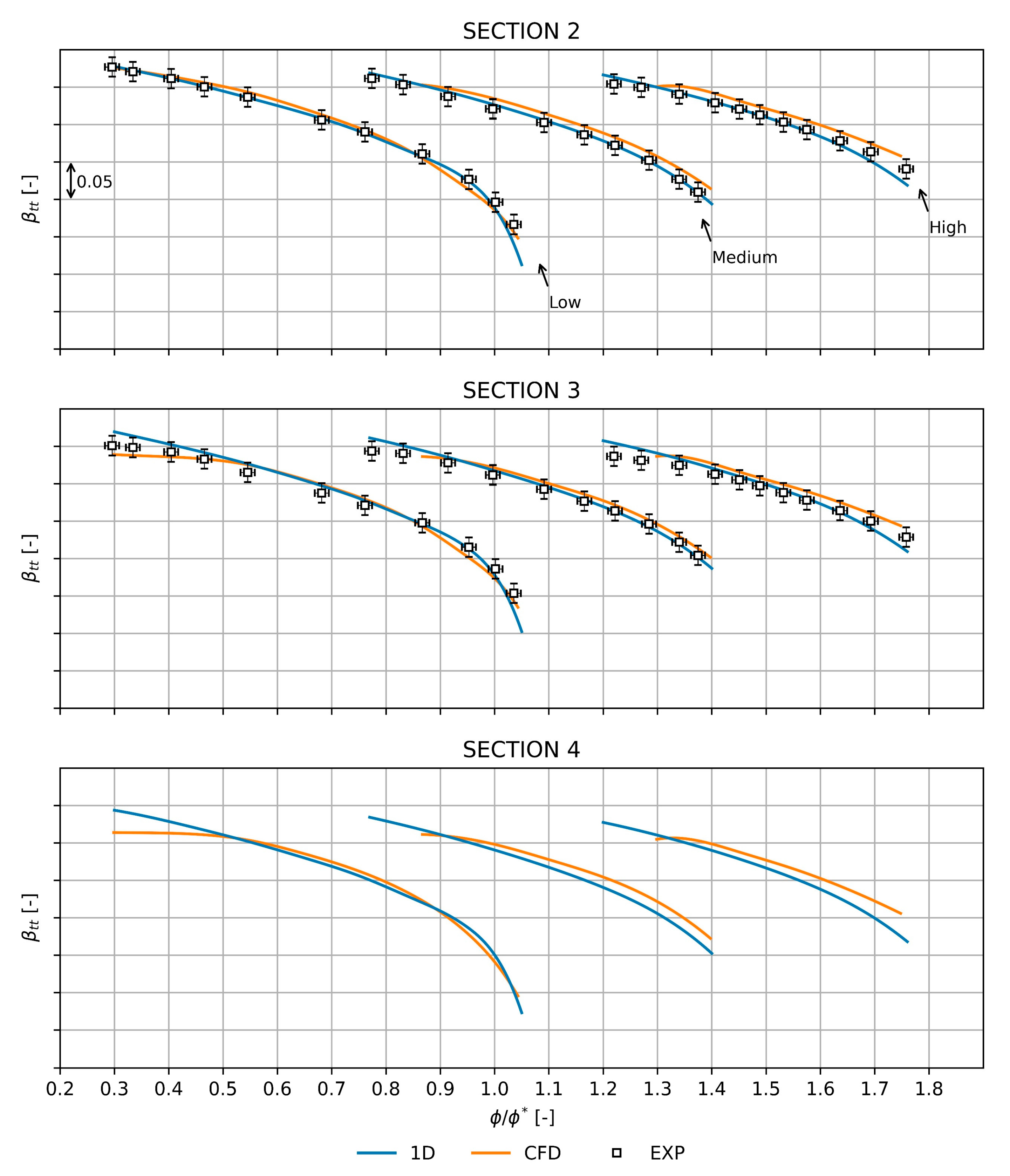


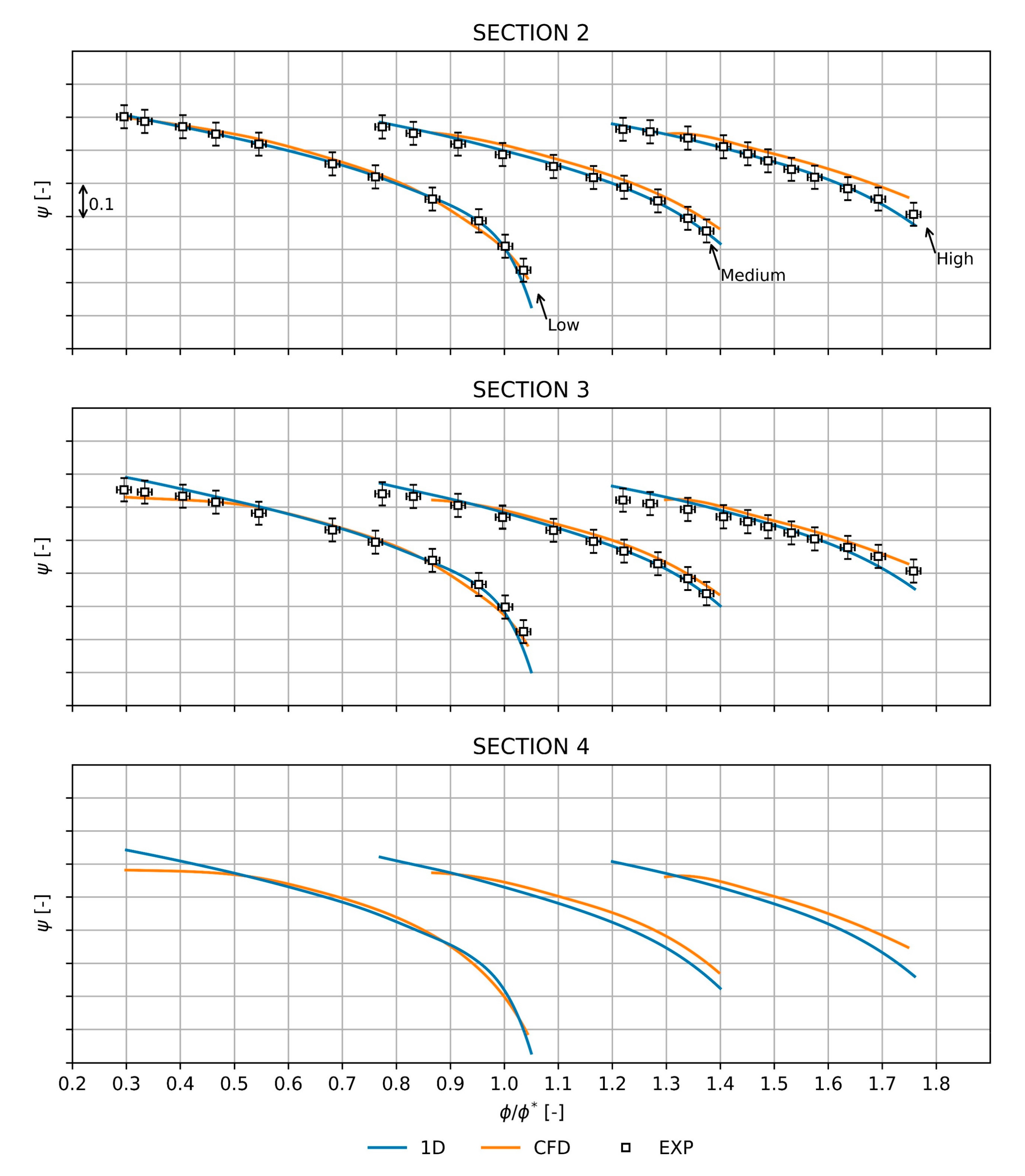
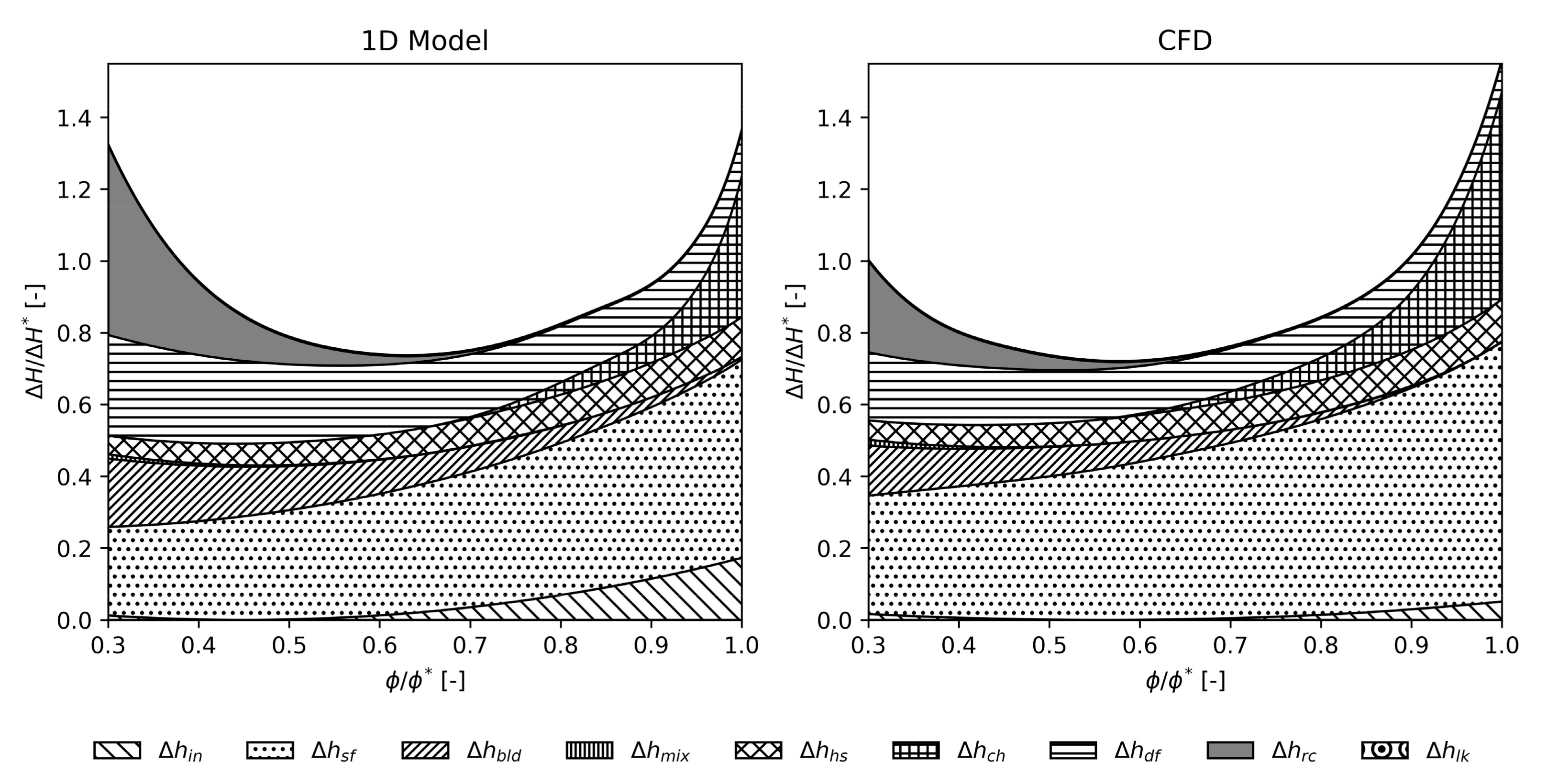
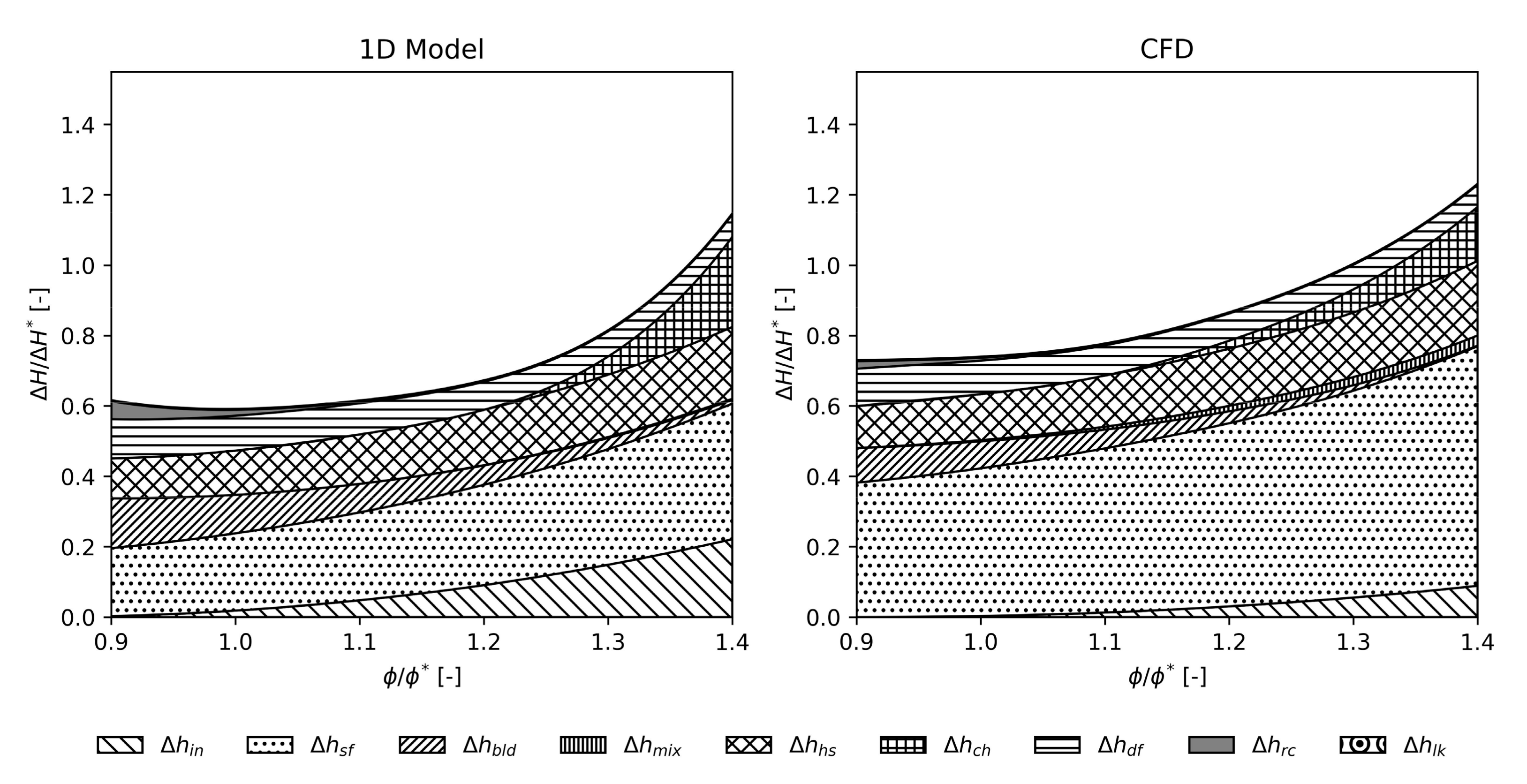

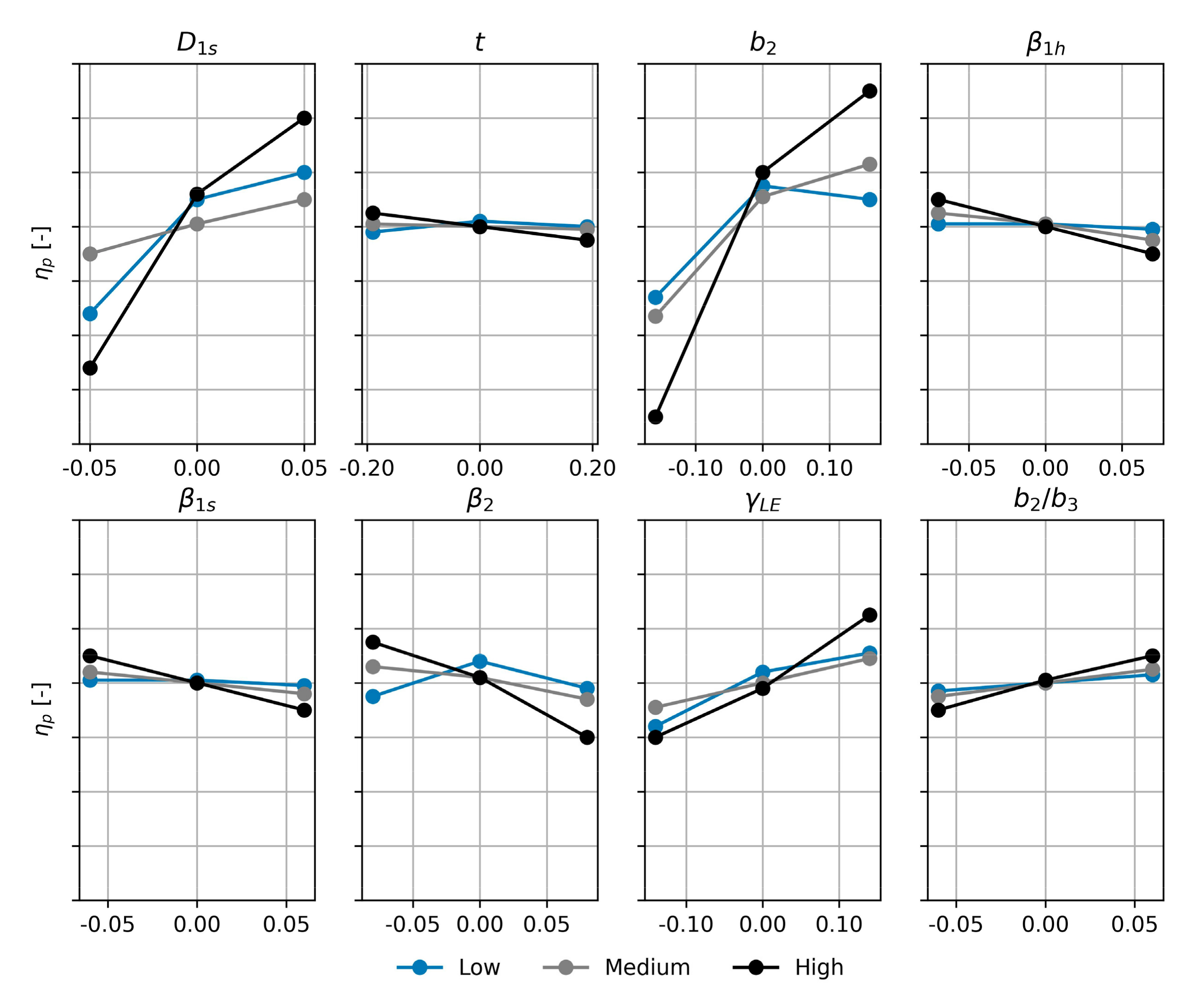

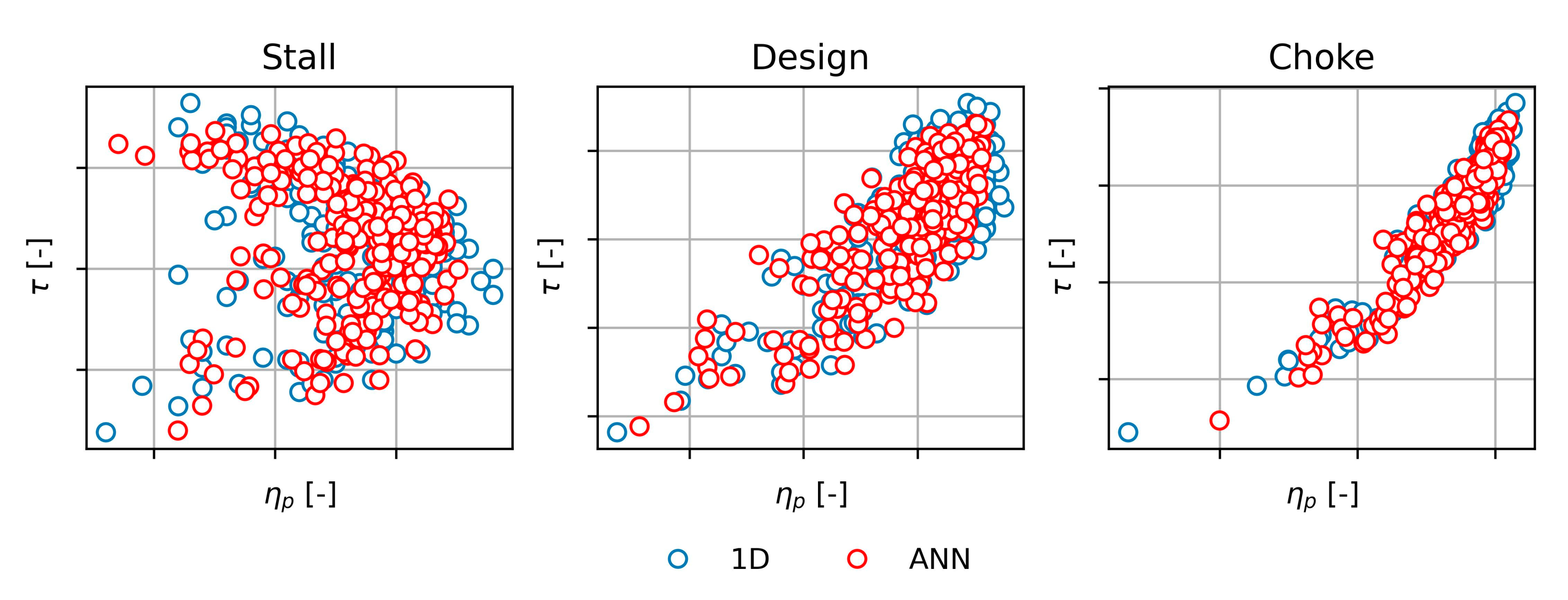



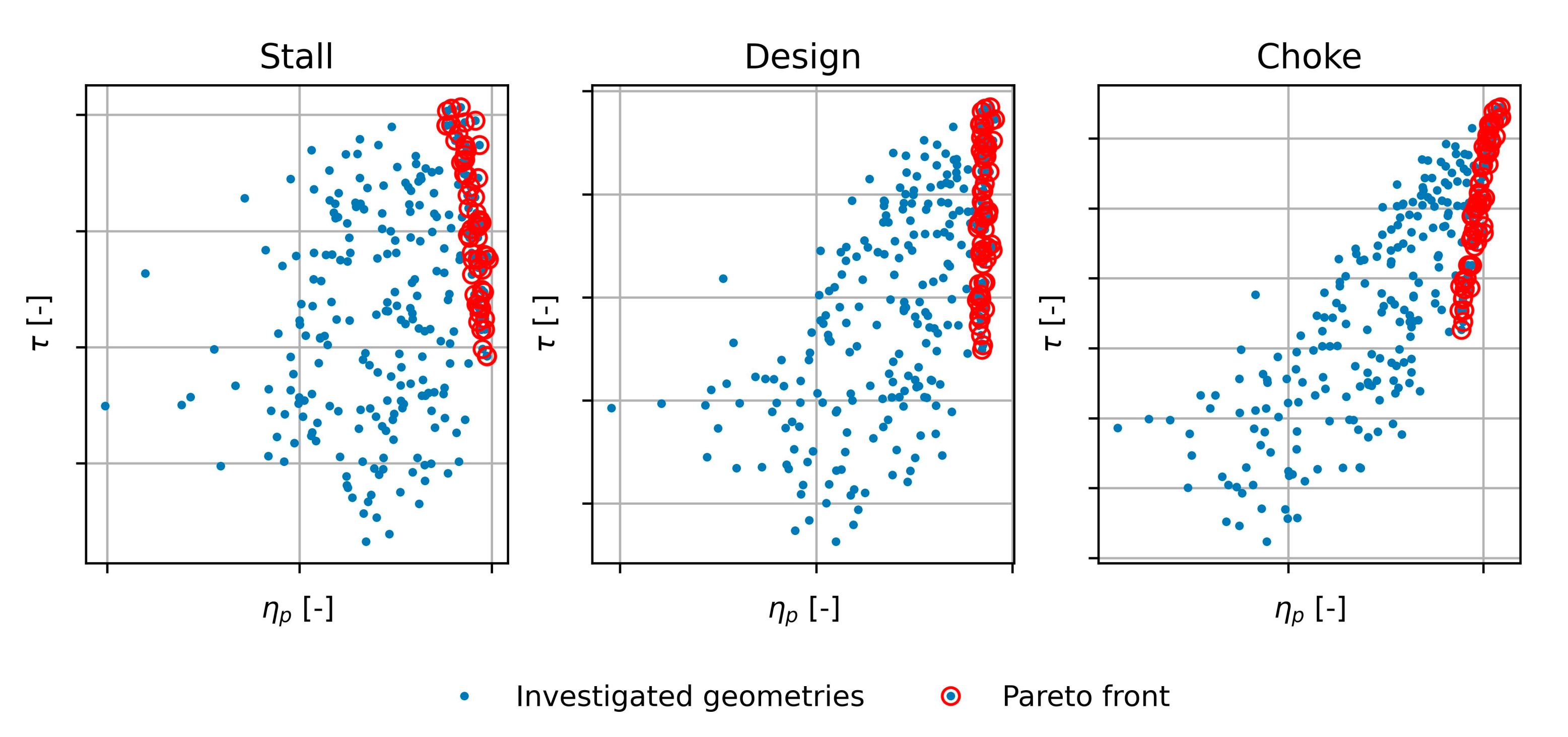
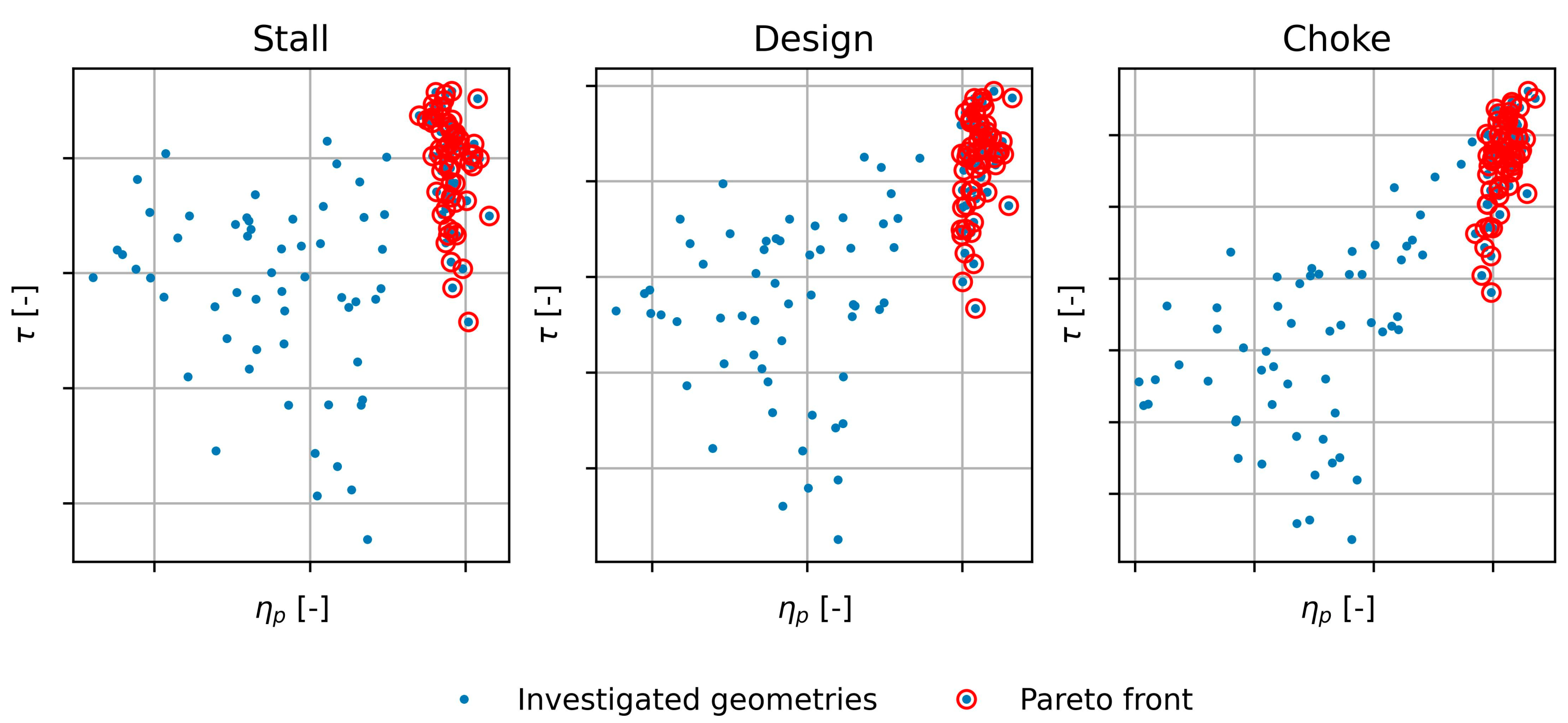
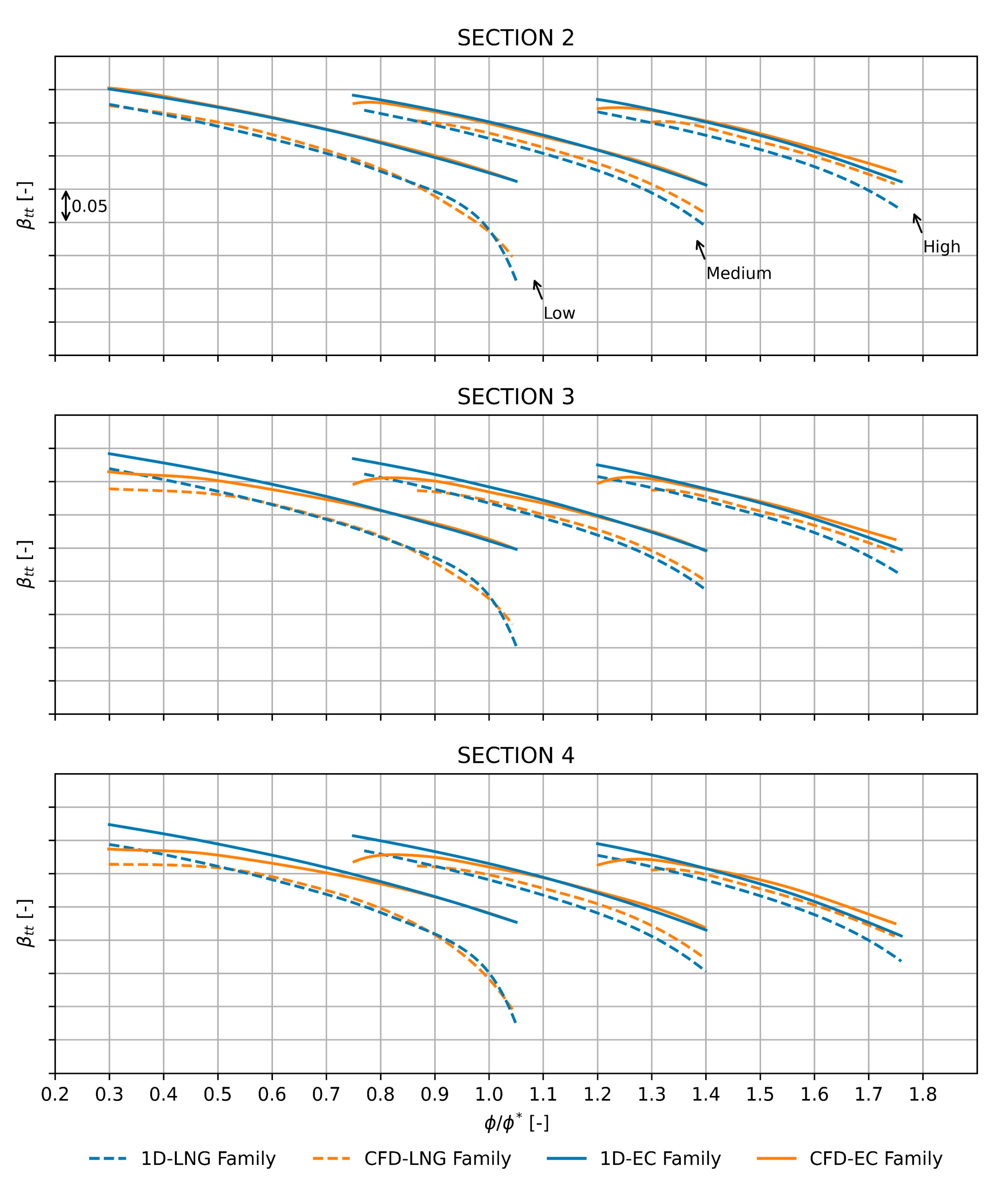


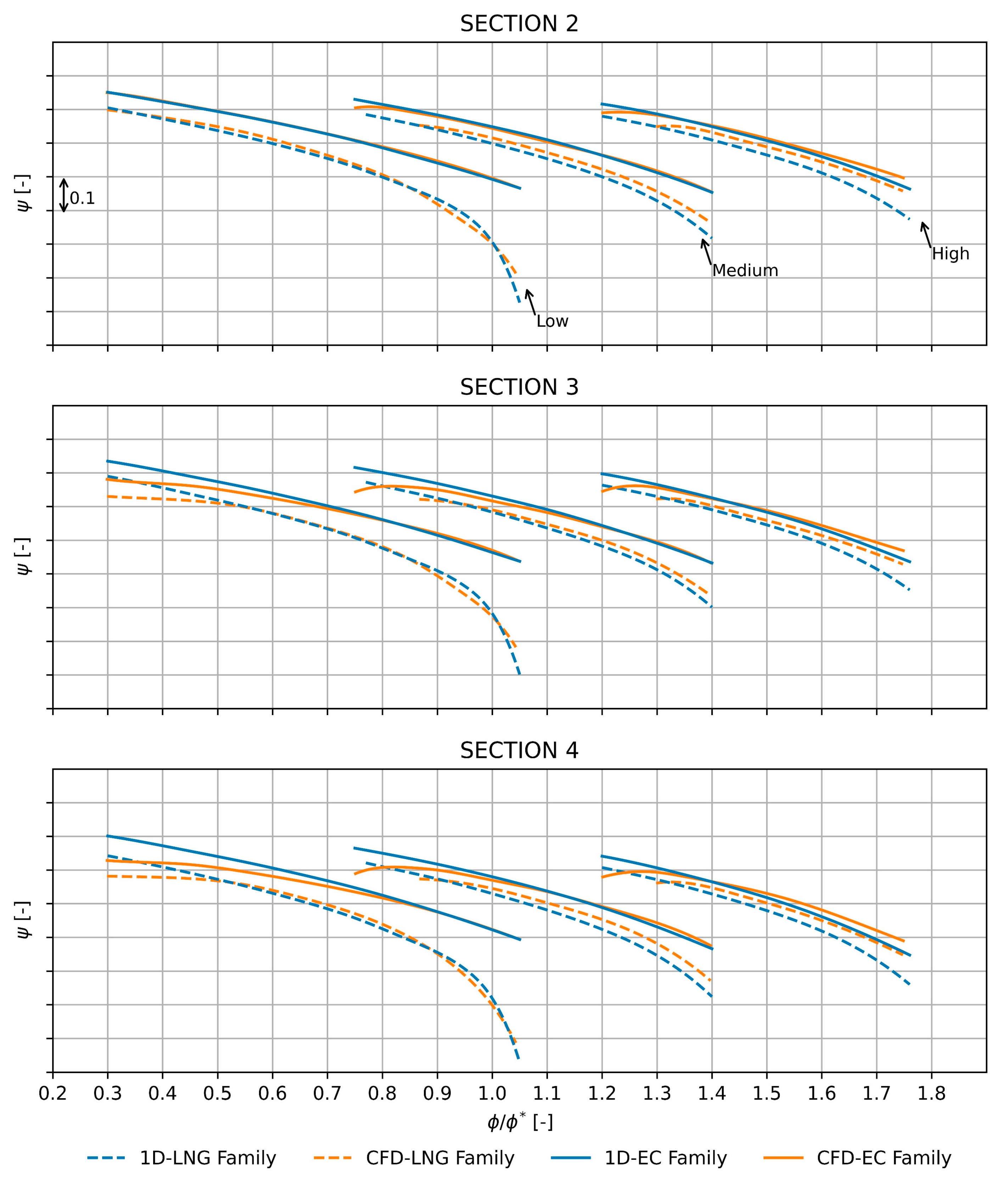
| Component | Loss Source | Loss Correlation * | Refs. |
|---|---|---|---|
| Impeller (Internal losses) | Incidence | [60] | |
| Blade-loading | with | [61] | |
| Mixing | [62,63] | ||
| Skin-friction | [54] | ||
| Choke | [34] | ||
| Hub-to-shroud distortion | [34] | ||
| Impeller (External losses) | Disc-friction | [64] | |
| Leakage | [34] | ||
| Recirculation | [35] | ||
| Diffuser | Vaneless diffuser | [56] | |
| Volute | Circumferential velocity | [57,58] | |
| Meridional velocity | [57,58] | ||
| Skin-friction | [57,58] | ||
| Exit-cone | [57,58] |
| Grid | No. of Elements | Polytropic Efficiency | Work Coefficient | ||
|---|---|---|---|---|---|
| Value | Error with G5 (%) | Value | Error with G5 (%) | ||
| G1 | 2.0 million | 0.989 | −1.1 | 1.008 | 0.8 |
| G2 | 2.5 million | 0.994 | −0.6 | 1.005 | 0.5 |
| G3 | 3.0 million | 0.997 | −0.3 | 1.002 | 0.2 |
| G4 | 3.5 million | 1.000 | 0.0 | 1.000 | 0.0 |
| G5 | 4.0 million | 1.000 | - | 1.000 | - |
| Numerical Setup | |
|---|---|
| Type of analysis | RANS with adiabatic walls |
| Type of grid | H-type |
| No. of Elements | 3.5 million |
| Discretization of convective fluxes | 2nd order TVD-MUSCL with Roe’s upwind scheme |
| Discretization of viscous fluxes | Central difference scheme |
| Turbulence closure | Wilcox’s k-ω model |
| Parallelization | Hybrid OpenMP/MPI architecture |
| Wall treatment | Wall resolution without wall functions |
| Near wall grid refinement | First element of 2.8 × 10−5 mm (y+ ≤ 1) |
| Parameter | Range of Variation (%) | ANOVA Admissible Value (%) |
|---|---|---|
| Constant | - | |
| (−5.0; 5.0) | −5.0; 0.0; 5.0 | |
| (−19.0; 19.0) | −19.0; 0.0; 19.0 | |
| Constant | - | |
| (−16.0; 16.0) | −16.0; 0.0; 16.0 | |
| (−7.0; 7.0) | −7.0; 0.0; 7.0 | |
| (−6.0; 6.0) | −6.0; 0.0; 6.0 | |
| (−8.0; 8.0) | −8.0; 0.0; 8.0 | |
| (−14.0; 14.0) | −14.0; 0.0; 14.0 | |
| (−6.0; 6.0) | −6.0; 0.0; 6.0 |
| Stall | Design | Choke | ||||
|---|---|---|---|---|---|---|
| Low flow stage | 0.1% | 0.2% | 0.2% | 0.2% | 0.8% | 0.3% |
| Medium flow stage | 0.2% | 0.1% | 0.2% | 0.1% | 0.5% | 0.3% |
| High flow stage | 0.2% | 0.1% | 0.2% | 0.2% | 1.0% | 0.3% |
Publisher’s Note: MDPI stays neutral with regard to jurisdictional claims in published maps and institutional affiliations. |
© 2022 by the authors. Licensee MDPI, Basel, Switzerland. This article is an open access article distributed under the terms and conditions of the Creative Commons Attribution (CC BY) license (https://creativecommons.org/licenses/by/4.0/).
Share and Cite
Bicchi, M.; Biliotti, D.; Marconcini, M.; Toni, L.; Cangioli, F.; Arnone, A. An AI-Based Fast Design Method for New Centrifugal Compressor Families. Machines 2022, 10, 458. https://doi.org/10.3390/machines10060458
Bicchi M, Biliotti D, Marconcini M, Toni L, Cangioli F, Arnone A. An AI-Based Fast Design Method for New Centrifugal Compressor Families. Machines. 2022; 10(6):458. https://doi.org/10.3390/machines10060458
Chicago/Turabian StyleBicchi, Marco, Davide Biliotti, Michele Marconcini, Lorenzo Toni, Francesco Cangioli, and Andrea Arnone. 2022. "An AI-Based Fast Design Method for New Centrifugal Compressor Families" Machines 10, no. 6: 458. https://doi.org/10.3390/machines10060458
APA StyleBicchi, M., Biliotti, D., Marconcini, M., Toni, L., Cangioli, F., & Arnone, A. (2022). An AI-Based Fast Design Method for New Centrifugal Compressor Families. Machines, 10(6), 458. https://doi.org/10.3390/machines10060458







